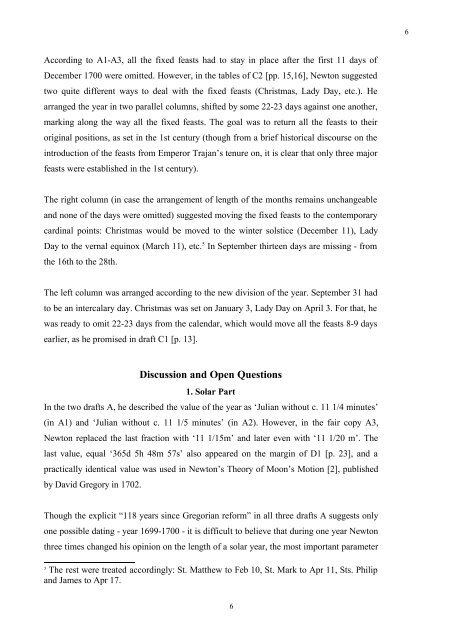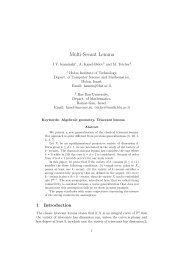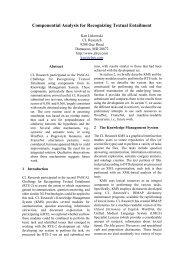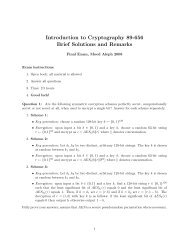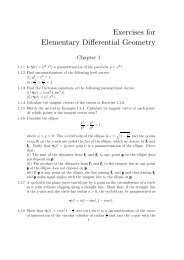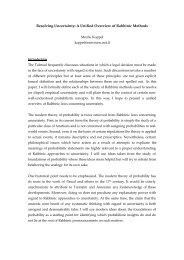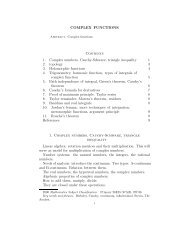Reform of the Julian Calendar as Envisioned by Isaac Newton
Reform of the Julian Calendar as Envisioned by Isaac Newton
Reform of the Julian Calendar as Envisioned by Isaac Newton
Create successful ePaper yourself
Turn your PDF publications into a flip-book with our unique Google optimized e-Paper software.
6<br />
According to A1-A3, all <strong>the</strong> fixed fe<strong>as</strong>ts had to stay in place after <strong>the</strong> first 11 days <strong>of</strong><br />
December 1700 were omitted. However, in <strong>the</strong> tables <strong>of</strong> C2 [pp. 15,16], <strong>Newton</strong> suggested<br />
two quite different ways to deal with <strong>the</strong> fixed fe<strong>as</strong>ts (Christm<strong>as</strong>, Lady Day, etc.). He<br />
arranged <strong>the</strong> year in two parallel columns, shifted <strong>by</strong> some 22-23 days against one ano<strong>the</strong>r,<br />
marking along <strong>the</strong> way all <strong>the</strong> fixed fe<strong>as</strong>ts. The goal w<strong>as</strong> to return all <strong>the</strong> fe<strong>as</strong>ts to <strong>the</strong>ir<br />
original positions, <strong>as</strong> set in <strong>the</strong> 1st century (though from a brief historical discourse on <strong>the</strong><br />
introduction <strong>of</strong> <strong>the</strong> fe<strong>as</strong>ts from Emperor Trajan’s tenure on, it is clear that only three major<br />
fe<strong>as</strong>ts were established in <strong>the</strong> 1st century).<br />
The right column (in c<strong>as</strong>e <strong>the</strong> arrangement <strong>of</strong> length <strong>of</strong> <strong>the</strong> months remains unchangeable<br />
and none <strong>of</strong> <strong>the</strong> days were omitted) suggested moving <strong>the</strong> fixed fe<strong>as</strong>ts to <strong>the</strong> contemporary<br />
cardinal points: Christm<strong>as</strong> would be moved to <strong>the</strong> winter solstice (December 11), Lady<br />
Day to <strong>the</strong> vernal equinox (March 11), etc. 5 In September thirteen days are missing - from<br />
<strong>the</strong> 16th to <strong>the</strong> 28th.<br />
The left column w<strong>as</strong> arranged according to <strong>the</strong> new division <strong>of</strong> <strong>the</strong> year. September 31 had<br />
to be an intercalary day. Christm<strong>as</strong> w<strong>as</strong> set on January 3, Lady Day on April 3. For that, he<br />
w<strong>as</strong> ready to omit 22-23 days from <strong>the</strong> calendar, which would move all <strong>the</strong> fe<strong>as</strong>ts 8-9 days<br />
earlier, <strong>as</strong> he promised in draft C1 [p. 13].<br />
Discussion and Open Questions<br />
1. Solar Part<br />
In <strong>the</strong> two drafts A, he described <strong>the</strong> value <strong>of</strong> <strong>the</strong> year <strong>as</strong> ‘<strong>Julian</strong> without c. 11 1/4 minutes’<br />
(in A1) and ‘<strong>Julian</strong> without c. 11 1/5 minutes’ (in A2). However, in <strong>the</strong> fair copy A3,<br />
<strong>Newton</strong> replaced <strong>the</strong> l<strong>as</strong>t fraction with ‘11 1/15m’ and later even with ‘11 1/20 m’. The<br />
l<strong>as</strong>t value, equal ‘365d 5h 48m 57s’ also appeared on <strong>the</strong> margin <strong>of</strong> D1 [p. 23], and a<br />
practically identical value w<strong>as</strong> used in <strong>Newton</strong>’s Theory <strong>of</strong> Moon’s Motion [2], published<br />
<strong>by</strong> David Gregory in 1702.<br />
Though <strong>the</strong> explicit “118 years since Gregorian reform” in all three drafts A suggests only<br />
one possible dating - year 1699-1700 - it is difficult to believe that during one year <strong>Newton</strong><br />
three times changed his opinion on <strong>the</strong> length <strong>of</strong> a solar year, <strong>the</strong> most important parameter<br />
5<br />
The rest were treated accordingly: St. Mat<strong>the</strong>w to Feb 10, St. Mark to Apr 11, Sts. Philip<br />
and James to Apr 17.<br />
6


